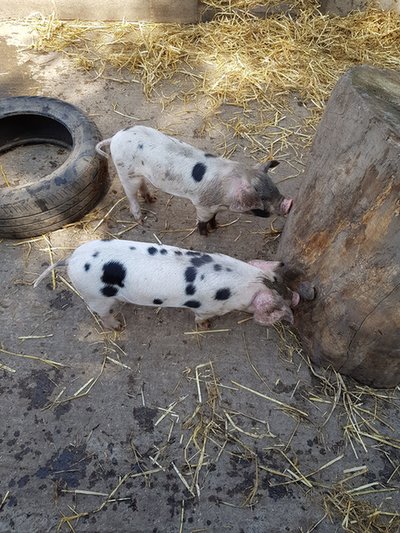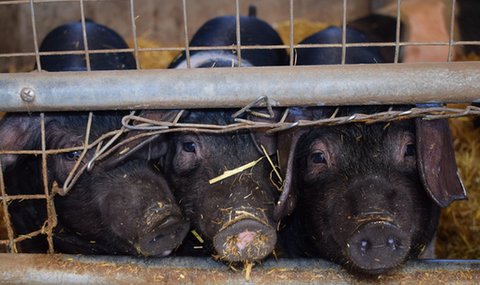INTERVIEW
The use-case Pig Farm Management focuses on optimising pig production through enhanced inter-operability of on-farm sensors and slaughterhouse data.
The goal of the use-case Pig Farm Management is to provide pig farmers with the right information to help them make better choices in the management of their farms. Why is this needed?
Many factors influence the animals at the farm. The farmer’s management decisions such as feed type or medical treatment, but also external factors such as an upcoming disease or hot weather. If the farmer knows the effect of a certain change or that a problem is on the horizon, he can take measures immediately.
Currently, farmers mainly rely on the visual inspection of their animals. They are experts, of course, but you can imagine that they cannot see how much a specific animal eats and drinks during the day or how much the temperature varies in a certain corner of the barn. For a farmer, it’s for example very useful to know if his pigs grow better after a feed type change or if they don’t because he changed the feed too abruptly.


With systems tested in this use case, will it be possible for the farmer to see how a specific animal does and make adjustments accordingly?
We aim at three things. The first is to build a monitoring system at group level. With this, the farmer can spot if things are going wrong in the barn, but also see how a medical treatment is catching on, or how the pigs respond to a feed change, for example. The next aim is to connect data throughout the chain. Currently, farmers get information on their production results from the slaughterhouse, which isn’t connected to the rest of his data. When we connect farm data to slaughterhouse data, the farmer can for example see that the meat from pigs in a certain corner of the barn is always a little lower in quality. Which then leads him to discover that the ventilation in that corner needs to be improved. The third aim is indeed to monitor animals individually.
One would expect that farmers already have a lot of information about their animals. What kind of information is lacking and what information will be collected in this use-case?
Visual inspection is key to running a farm successfully. But it’s also time consuming and difficult for the farmer to see all pigs in detail. Even more so, because prey animals tend to hide their difficulties as a survival mechanism. In this -se case we set up 24/7 automated monitoring in addition to the farmer’s visual inspection. Sensors will collect data on feed intake, water consumption, pig weight and climate in the barn. The sensors on the market for feed intake and water consumption can only collect data on group level. With our research, we aim to improve these sensors to collect information on individual pig level, too.
Boar taint, the unpleasant odour sometimes occurring in pork meat, is one of the problems that will (hopefully) be reduced with the help of IoT technology. How big is this problem and how can the technology tested in this use-case help?
Boar taint is a rising problem in the EU because the practice of castrating male piglets is diminishing for welfare reasons. From years and years of research we know that feed type,
genetics and circumstances in which the pigs grow up influence the presence of boar taint. We want to visualise these factors and improve the farmer’s practical knowledge, which will help to reduce boar taint.
We’ve officially launched this project last January and it will run for four years. Where do you stand now? What are the next steps in your UC?
At the moment, we are selecting farms to join in the use-case. Criteria such as having already some sensor technology in place, not castrating the piglets and being eager to cooperate are important to us. We will choose five farms, including one organic farm and the ILVO research farm, where we can focus on the individual monitoring of the pigs. The next steps are to set up the farms, map what data they already collect and check how to integrate the data. Then we start with the installation of additional sensors, data collection and the development of the warning systems. We hope to start working on the farms by autumn.
So you’re testing different things at different farms?
We aim to test as many things as we can on all the farms, but monitoring pigs on an individual level is such a new technology that we need to test this first in a more controlled environment.
Will there be a marketable product at the end?
The benefits for the farmers and for the pigs are very tangible and the technology is available. Our partners in the use-case are keen to develop this technology and bring it to the market. We have quite some questions from farmers, too. So yes, I definitely think so.
When we speak to you again in four years’ time, what do you hope to have achieved by then?
By then I hope we can collect as much data as possible from the farm automatically. And even more importantly, analyse, integrate and present data in such a way that farmers understand much better what goes on in their production and react much quicker to changes. The care for the pigs will be much better suited to their needs, increasing health and well-being. The farmer will also gain a deeper understanding of his farm, because the combination of data streams will show relations that aren’t visible to the eye.
On project level, I think it will be nice to get consumers involved, too. Especially in animal husbandry, the use of technology is often seen as making a farm into a factory in which animals are only a production unit. The opposite is true: we aim to improve the welfare of the pigs and ensure they have enough food of the right quality, enough water, activities and an environment in which they feel well. Even on small farms this technology can aid farmers to gain insight in the welfare and health of their animals.
Partners in this use case:
Author: Renske Solkesz, Schuttelaar & Partners
use case
Pig Farm Management
Jarissa Maselyne
MSc Electromechanical engineering, PhD Bioscience engineering. Works at the Flanders research institute for agriculture, fisheries & food (ILVO).





